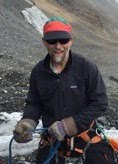Today was a day of flying. After a nice night at Raven in the 'E-shack', a small wood structure designed to house the Raven crew in the event of an emergency, I awoke to clear sunny weather, with very little wind- unusual for Raven, where wind is such a constant that the camp is powered entirely by wind and solar energy.

The 'E-shack', the guest room at Raven.
My flight back to Kangerlussuaq was due to arrive around 11 am, so I had some time on my hands before it arrived, since I'd finished my work the evening before. I took the opportunity to show a couple of folks around the DYE site, an abandoned radar post used by the air force (actually I think it was the 'Space Command') to watch for Soviet missles during the cold war. It's a couple of kilometers from Raven camp, so we went for a look around.

DYE-2, part of the Distant Early Warning system from the cold war era.
While we were there, Silver called on the radio to tell us that the flight was cancelled for the day (no weather problems, but there had been a problem with one of the airplanes, and they always need a backup airplane if they're landing on the ice). So, we had all the time we wanted to look around.
As we were finishing up, Silver called again to tell us that plans had changed again, that the plane was on its way, and that the new plan was for me to turn around, once I got to Kangerlussuaq, and fly right to Summit that afternoon! Plans change quickly in the arctic.

Silver reporting weather conditions to the airplanes.
So, back to camp, get ready to go, and in fact the plane came in as scheduled and picked me up, along with my gear. We flew back to Kangerlussuaq, and didn't even need to take my gear off the plane- this was the same plane that was going to fly to Summit. I got off, however, since they were going to need to fuel the plane and there would be some waiting. So I waited on the runway for a while, and finally we were ready to fly again. This flight was full with cargo, so I got to fly first-class; up on the flight deck with the pilots, flight engineer, and navigator. The scenery was spectacular as we flew over the hills towards the ice-edge, the pilot pointing out features of interest:

We were able to talk over the noise of the engines (millitary planes are much louder than civillian ones) using a headset intercom:

Once we got out past the edge of the ice sheet, the topography got less interesting, and the rest of the 2+ hour flight was passed mostly with the plane on autopilot. When we reached the location of Summit camp, however, we discovered that during the 2 hours we'd been flying a low fog bank had come in, making it dificult to see the runway, or any of the camp structures. We knew where the camp was because we had precise GPS co-ordinates, and the LC-130's forward-looking radar could 'see' the camp and the skiway markers, but when flying onto a snow runway it's important to have visibility.

This picture shows all we could see- we're at an altitude of about 250 feet- that's low!
Using the radar and maps of the skiway, the navigator skillfully put us on the approach. But even with great training and high-tech tools, we still needed to see. We flew in low, close to the skiway, and could only see the marker flags directly below us, rather than ahead of us. We didn't want to fly lower than 100 feet without a clear view, because there was a 100 foot tower in camp for sampling instruments. At the very last moment, the split-second decision had to be made- try to land or fly around for another try? Without good visibility, we had to go around. Again and again we tried- but the visibility wasn't getting any better. The pilot tried using diffferent goggles and sunglasses in an effort to see, but nothing worked. Eventually we had to face the fact that we were running low enough on fuel that we needed to turn back. So we radioed camp to give our apologies, turned around and headed back to Kangerlussuaq.
On the way back to Kangerlussuaq, we flew low over the ice edge again, with a spectacular view of the crevasse patterns that form when the ice is pulled in different directions going over steep topography:

Crevasse patterns at the ice edge. The directions of the crevasses can tell us about how the ice is moving- can you think of why?
By about 10pm, we were back in Kangerlussuaq. It'd been a long day, with many miles flown. Tomorrow morning the plan is for the summit flight to leave at 0800, so it'll be another early morning....
That's all for today- see you tomorrow!



















































